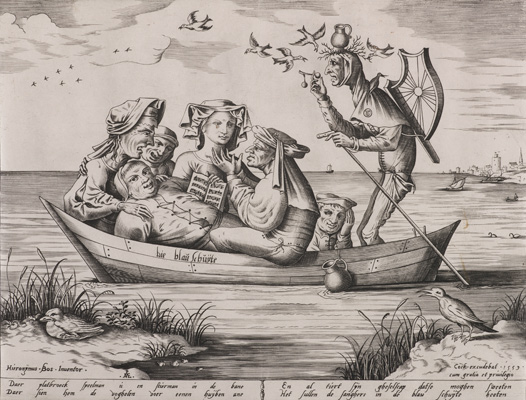When Beyond Bosch: The Afterlife of a Renaissance Master in Print opens at the Harvard Art Museums this month, visitors may be surprised to find that the exhibition doesn’t actually include any original works by Netherlandish master Hieronymus Bosch (c. 1450–1516). In fact, that’s the whole point.
“The exhibition is organized around the idea that Bosch’s art provided inspiration for other artists who followed him,” said Danielle Carrabino, associate research curator in European and American art at the Harvard Art Museums. “It’s really a show about prints, and the origins of printmaking, at the moment when prints were just starting to become a new artistic medium. Prints allowed Bosch’s imagery—and artists imitating his imagery—to be disseminated to a much wider audience.” That accessibility helped Bosch’s legacy thrive.
Organized by and first exhibited at the Saint Louis Art Museum, Beyond Bosch was co-curated by Marisa Bass, assistant professor of art history and archaeology at Washington University in Saint Louis, and Elizabeth Wyckoff, curator of prints, drawings, and photographs at the Saint Louis Art Museum. Bass and Wyckoff’s goal was to highlight Bosch’s incredible—and enduring—afterlife in print.
“He had an extraordinary imagination, and that has inspired generation after generation,” Wyckoff said.
Even 500 years after his death, Bosch’s works, such as The Garden of Earthly Delights, remain widely known. And his subjects—hybrid creatures behaving in strange, comical, and lewd ways in unusual and sometimes hellish settings—are just as puzzling and bizarre today as they were during the artist’s time. “There’s such a wealth of detail” in Boschian prints, Wyckoff said. “There’s horror, but there’s also humor.”
Carrabino, who curated the Harvard Art Museums presentation of the exhibition, said that although there’s been much written about Bosch, “I think we’re still asking the questions that people were when he first made his images. The works provide such an interesting platform for interpretation. Different people will see different themes in the same works; some will see religious themes, others will see moralizing images. It’s in many ways still new and mysterious.”
In Antwerp, near Bosch’s hometown of ’s-Hertogenbosch, artists producing prints were profoundly influenced by Bosch’s imaginary creations (as were collectors, whose interest in Boschian prints fueled a thriving market for them). His contemporary Alart du Hameel made a number of engravings directly related to Bosch’s paintings. Later artists, including Pieter Bruegel the Elder, worked together with the print publisher Hieronymus Cock to expand the popularity of Boschian prints with such engravings as Big Fish Eat Little Fish (1557). Signed with Bosch’s name, the engraving is both inspired by Bosch’s work and rivals it, Wyckoff said.
The Tree-Man, a print from about 1600 by an unknown artist, reimagines the anthropomorphic tree of The Garden of Earthly Delights as a figure surrounded by spectators pointing and staring. “It can be viewed as a meta-commentary on the idea of Bosch as a phenomenon,” said Marisa Bass. “Everyone wants to understand him.”
While the objects from the St. Louis exhibition primarily represent Bosch’s influence in the 16th and 17th centuries, the presentation at the Harvard Art Museums also demonstrates his reach into the following three centuries. In curating the exhibition for our University Research Gallery, Carrabino drew from the museums’ rich prints collection to add seven works, including Head of a Peasant Woman, a drawing made in the manner of Bosch.
Antoine Roegiers’s 2011 film The Seven Deadly Sins (which was also on view in St. Louis) rounds out the exhibition, offering a look at how Boschian imagery persists into the 21st century.
The result is a show that will resonate with a range of audiences. “It is both marvelously engaging to a general audience and has scholarly impact,” Wyckoff said. “Museum visitors in St. Louis were endlessly fascinated by these prints.” No doubt visitors in Cambridge will have the same experience.
Beyond Bosch: The Afterlife of a Renaissance Master in Print is on view at the Harvard Art Museums through May 8, 2016.


